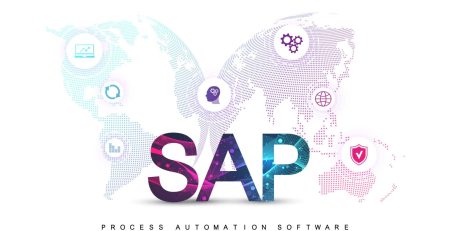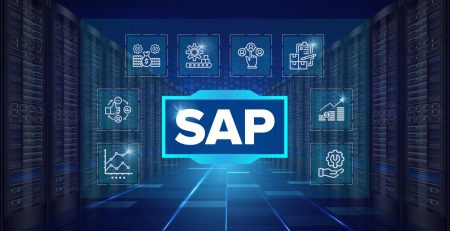Innovate and Thrive: The Path to SAP Intelligent Enterprise
Unleash the power of the SAP Intelligent Enterprise and pave the way for innovation and success in your organization.
The Future of SAP: Intelligent Enterprise
In today’s rapidly evolving business landscape, innovation and transformation have become essential for organizations to stay competitive. SAP, a leading provider of enterprise software solutions, has introduced the concept of the SAP Intelligent Enterprise as the future of SAP. This strategic approach combines advanced technologies, industry-specific adaptations, and cloud solutions to enable organizations to thrive in the digital age.
Embracing Innovation and Transformation
As technology continues to advance, businesses must embrace innovation and transformation to keep pace with changing market demands. The SAP Intelligent Enterprise represents a shift from traditional enterprise resource planning (ERP) systems to an intelligent suite of integrated applications and technologies.
By adopting the SAP Intelligent Enterprise, organizations can leverage cutting-edge technologies such as artificial intelligence, machine learning, and Internet of Things (IoT) to drive operational efficiency, enhance customer experiences, and gain real-time insights. This innovative approach empowers businesses to streamline processes, make data-driven decisions, and adapt quickly to market changes.
An Introduction to the SAP Intelligent Enterprise
The SAP Intelligent Enterprise is a holistic framework that combines various components to create an intelligent, connected, and agile organization. At its core, it leverages the power of cloud solutions and digital transformation to enable businesses to reimagine their operations and deliver exceptional value to customers.
Cloud solutions play a pivotal role in the SAP Intelligent Enterprise, providing organizations with the flexibility, scalability, and cost-effectiveness needed to thrive in today’s dynamic business environment. By harnessing the power of the cloud, businesses can leverage cutting-edge technologies, access real-time data, and achieve faster time-to-value. To learn more about the benefits of SAP cloud solutions, check out our article on SAP cloud computing.
Digital transformation is another key aspect of the SAP Intelligent Enterprise. It involves reimagining business processes, leveraging digital technologies, and driving organizational change to create a more agile and customer-centric environment. By embracing digital transformation, businesses can optimize operations, enhance productivity, and deliver seamless experiences across all touchpoints. To dive deeper into the topic of SAP digital transformation, visit our article on SAP digital transformation.
In summary, the SAP Intelligent Enterprise represents the future of SAP, offering organizations a pathway to innovation, agility, and success in the digital era. By embracing the concept of intelligent enterprise and harnessing the power of cloud solutions and digital transformation, businesses can position themselves at the forefront of industry trends and drive sustainable growth.
Key Components of the SAP Intelligent Enterprise
To understand the SAP Intelligent Enterprise, it is essential to explore its key components, which include cloud solutions and digital transformation and industry-specific adaptations and customizations.
Cloud Solutions and Digital Transformation
Cloud solutions play a pivotal role in the SAP Intelligent Enterprise. By leveraging cloud computing technology, businesses can streamline their operations, increase flexibility, and reduce infrastructure costs. Moving to the cloud offers numerous benefits, including scalability, accessibility, and security.
With SAP cloud solutions, organizations can take advantage of a wide range of cloud-based services, such as software-as-a-service (SaaS), platform-as-a-service (PaaS), and infrastructure-as-a-service (IaaS). These solutions enable businesses to deploy SAP applications and services in a scalable and cost-effective manner.
Digital transformation, another key component, goes hand in hand with cloud solutions. It involves reimagining business processes and leveraging digital technologies to drive innovation, efficiency, and growth. By embracing digital transformation with SAP, organizations can optimize their operations, enhance collaboration, and unlock new business opportunities.
To learn more about the benefits and implementation of SAP cloud solutions and digital transformation, refer to our articles on SAP cloud computing and SAP digital transformation.

Industry-Specific Adaptations and Customizations
Every industry has unique requirements and challenges. SAP understands this and offers industry-specific adaptations and customizations to cater to diverse business needs. These adaptations ensure that organizations can leverage the full potential of SAP solutions while aligning with industry standards and regulations.
By tailoring SAP solutions to specific industries such as manufacturing, retail, healthcare, or finance, businesses can optimize their processes and gain a competitive edge. These industry-specific adaptations encompass functionalities, workflows, and reporting capabilities that are tailored to meet specific industry requirements.
Customizations within the SAP Intelligent Enterprise allow organizations to further refine and personalize their SAP solutions. These customizations can include modifying user interfaces, developing specific reports and dashboards, and integrating with other applications.
To explore how SAP solutions can be adapted and customized for specific industries, including best practices and case studies, refer to our articles on SAP cloud solutions and SAP innovations.
By embracing cloud solutions, digital transformation, industry-specific adaptations, and customizations, businesses can unlock the full potential of the SAP Intelligent Enterprise. These key components empower organizations to drive innovation, enhance efficiency, and stay ahead in an ever-evolving digital landscape.

Benefits of the SAP Intelligent Enterprise
The SAP Intelligent Enterprise offers a multitude of benefits for organizations that embrace its innovative solutions. By leveraging cloud-based technologies, industry-specific adaptations, and cutting-edge innovations, businesses can experience enhanced efficiency, improved customer experience, and real-time insights for better decision-making.
Enhanced Efficiency and Productivity
With the SAP Intelligent Enterprise, organizations can streamline their operations and optimize workflows, leading to enhanced efficiency and productivity. By leveraging cloud solutions and digital transformation, businesses can automate manual processes, reduce paperwork, and eliminate redundant tasks. This allows employees to focus on more value-added activities, ultimately driving productivity and improving overall business performance.
Additionally, the SAP Intelligent Enterprise empowers organizations to integrate various systems and data sources, providing a unified view of information. This enables seamless collaboration across departments and enhances cross-functional communication, leading to improved coordination and increased efficiency.
Improved Customer Experience and Engagement
Customer experience is a key differentiator in today’s competitive business landscape. The SAP Intelligent Enterprise helps organizations deliver exceptional customer experiences by enabling personalized interactions and seamless engagement throughout the customer journey.
By leveraging industry-specific adaptations and customizations, businesses can tailor their solutions to meet the unique needs of their customers. This enables organizations to provide relevant and targeted experiences, resulting in increased customer satisfaction and loyalty.
Furthermore, the SAP Intelligent Enterprise enables organizations to gain a comprehensive view of their customers by integrating data from various touchpoints. This allows businesses to understand customer preferences, anticipate their needs, and deliver proactive and personalized services, ultimately enhancing customer engagement and driving business growth.
Real-Time Insights and Decision-Making
In the era of data-driven decision-making, real-time insights are crucial for organizations to stay competitive. The SAP Intelligent Enterprise provides businesses with access to real-time data and analytics, enabling informed decision-making and agile responses to changing market dynamics.
By harnessing the power of artificial intelligence and machine learning, the SAP Intelligent Enterprise can analyze vast amounts of data and generate actionable insights. This empowers organizations to identify trends, anticipate market changes, and make data-driven decisions that drive business success.
Through the integration of Internet of Things (IoT) devices and sensors, the SAP Intelligent Enterprise enables organizations to collect real-time data from connected assets. This data can be leveraged to optimize processes, improve operational efficiency, and drive innovation.
By embracing the SAP Intelligent Enterprise, organizations can unlock significant benefits, including enhanced efficiency and productivity, improved customer experience and engagement, and real-time insights for better decision-making. These advantages position businesses to thrive in an increasingly digital and competitive landscape, driving growth and success.
Implementing the SAP Intelligent Enterprise
To fully leverage the potential of the SAP Intelligent Enterprise, a strategic and well-executed implementation process is essential. This section will guide you through the key steps involved in implementing the SAP Intelligent Enterprise, including assessing organizational readiness, planning and executing the transformation, and overcoming challenges to ensure success.
Assessing Organizational Readiness
Before embarking on the transformation journey towards the SAP Intelligent Enterprise, it is crucial to assess your organization’s readiness for change. This involves evaluating the current state of your business processes, IT infrastructure, and workforce capabilities. Consider the following factors:
- Business Processes: Review and analyze your existing business processes to identify areas that can be streamlined, optimized, or automated using the SAP Intelligent Enterprise. This assessment will help you understand how the new system can align with your desired business outcomes.
- IT Infrastructure: Evaluate your current IT landscape to determine its compatibility with the SAP Intelligent Enterprise. Assess the readiness of your hardware, software, and network infrastructure to support the implementation. If necessary, consider SAP cloud computing solutions to facilitate a smooth transition to the cloud. Check out our article on SAP cloud solutions for more information.
- Workforce Capabilities: Assess the skills and knowledge of your workforce to ensure they are equipped to embrace the new technologies and processes associated with the SAP Intelligent Enterprise. Identify any gaps and develop training plans to empower your employees and facilitate a seamless transition. Explore our article on SAP digital transformation for insights on managing workforce changes effectively.
Planning and Executing the Transformation
Once you have assessed your organizational readiness, it’s time to plan and execute the transformation towards the SAP Intelligent Enterprise. This phase involves several key activities:
- Define Objectives: Clearly articulate your goals and objectives for implementing the SAP Intelligent Enterprise. Identify the specific business outcomes you aim to achieve, such as increased efficiency, improved customer experience, or enhanced decision-making capabilities.
- Design Solution: Collaborate with SAP experts or implementation partners to design a solution tailored to your organization’s unique requirements. This involves configuring the SAP system, integrating it with existing applications, and defining customizations to meet industry-specific needs. Consider exploring our article on SAP innovations for insights into the latest SAP advancements.
- Develop Implementation Plan: Create a detailed project plan that outlines the tasks, timelines, and resources required for the implementation. Assign roles and responsibilities to team members and establish communication channels to ensure effective coordination and collaboration.
- Execute and Monitor: Execute the implementation plan based on the defined timelines and milestones. Monitor the progress of the project closely, addressing any roadblocks or issues that arise promptly. Regularly communicate updates to stakeholders to keep them informed and engaged.
Overcoming Challenges and Ensuring Success in Sap intelligent enterprise
Implementing the SAP Intelligent Enterprise can present various challenges that need to be overcome to ensure a successful transformation. Here are some common challenges and strategies to address them:
- Change Management: Resistance to change can hinder the adoption of new technologies and processes. Implement a comprehensive change management strategy that includes clear communication, training programs, and stakeholder engagement to help employees embrace the change and leverage the benefits of the SAP Intelligent Enterprise.
- Data Migration: Migrating data from legacy systems to the SAP Intelligent Enterprise can be complex. Develop a robust data migration strategy, ensuring data integrity, accuracy, and security. Consider seeking assistance from experienced SAP consultants or partners to navigate this process smoothly.
- Integration Complexity: Integrating the SAP system with existing applications and systems can be challenging. Collaborate with IT experts to design and implement a seamless integration plan, leveraging SAP cloud migration techniques if necessary. Our article on SAP cloud migration provides valuable insights into best practices for migrating to the cloud.
By assessing organizational readiness, planning and executing the transformation, and proactively addressing challenges, you can successfully implement the SAP Intelligent Enterprise. Remember, this journey is not just about technology but also about empowering your organization to embrace innovation, drive digital transformation, and thrive in the ever-evolving business landscape.

The Road Ahead: Trends and Innovations in SAP
As we look ahead to the future of SAP, there are several exciting trends and innovations that are shaping the path to an intelligent enterprise. These advancements are revolutionizing the way businesses operate and are poised to drive innovation and efficiency in the SAP ecosystem. Let’s explore three key trends: Artificial Intelligence and Machine Learning, Internet of Things (IoT) Integration, and Blockchain Technology and Distributed Ledgers.
Artificial Intelligence and Machine Learning
Artificial Intelligence (AI) and Machine Learning (ML) are transforming the SAP landscape by enabling intelligent automation, predictive analytics, and enhanced decision-making capabilities. With AI and ML, SAP systems can analyze vast amounts of data, identify patterns, and make intelligent recommendations. This empowers businesses to automate repetitive tasks, optimize processes, and uncover valuable insights that drive business growth.
From customer service chatbots to intelligent supply chain management, AI and ML are revolutionizing various aspects of SAP operations. These technologies not only streamline processes but also enhance the overall user experience. By leveraging AI and ML, businesses can improve efficiency, reduce costs, and deliver personalized experiences to their customers. To learn more about SAP innovations, check out our article on SAP innovations.
GETTING STARTED
Transform Your Business Today - Get Your Custom Quote Now
- Tailored Solutions: Receive a personalized quote that aligns perfectly with your business needs and goals.
- Expert Guidance: Leverage Orlando Monteiro's extensive experience in business transformation and digital innovation.
- Cost-Effective Strategies: Discover how you can optimize your operations and reduce costs with our expert solutions.
- Immediate Impact: Start seeing tangible results in your business efficiency and productivity right away.
- Long-Term Success: Embark on a journey towards sustainable growth and competitive advantage with our strategic guidance.
Enter Details in This Form:
Internet of Things (IoT) Integration
The Internet of Things (IoT) is playing a pivotal role in the SAP landscape by connecting devices, sensors, and machines, and enabling real-time data exchange. With IoT integration, businesses can gather valuable data from various sources, such as manufacturing equipment, vehicles, and wearable devices. This data can then be analyzed within the SAP system to optimize operations, improve maintenance processes, and enhance decision-making.
By harnessing the power of IoT, businesses can achieve increased visibility, operational efficiency, and productivity. For example, in the manufacturing industry, IoT integration enables predictive maintenance, reducing downtime and optimizing asset utilization. In the logistics sector, IoT-powered tracking and monitoring systems provide real-time visibility into the supply chain, ensuring timely deliveries and efficient inventory management. To explore the potential of cloud-based solutions in the SAP ecosystem, visit our article on SAP cloud computing.
Blockchain Technology and Distributed Ledgers
Blockchain technology and distributed ledgers are emerging as powerful tools for secure and transparent transactions within the SAP ecosystem. By utilizing blockchain, businesses can create immutable and decentralized records of transactions, ensuring trust and transparency in complex supply chains, financial processes, and digital identity management.
With blockchain integration, SAP systems can enable secure and efficient transactions, reduce fraud, streamline auditing processes, and enhance data privacy. For example, in the finance industry, blockchain technology can facilitate instant and secure cross-border payments, eliminating intermediaries and reducing costs. In supply chain management, blockchain provides end-to-end visibility, ensuring the authenticity and traceability of products. To explore the potential of digital transformation in the SAP landscape, check out our article on SAP digital transformation.
As SAP continues to evolve, it is essential for businesses to stay informed about the latest trends and innovations. By embracing advancements in AI and ML, IoT integration, and blockchain technology, businesses can unlock new possibilities, optimize operations, and position themselves as leaders in the SAP ecosystem. The future is bright, and these trends pave the way for a more intelligent and innovative SAP landscape.












Leave a Reply